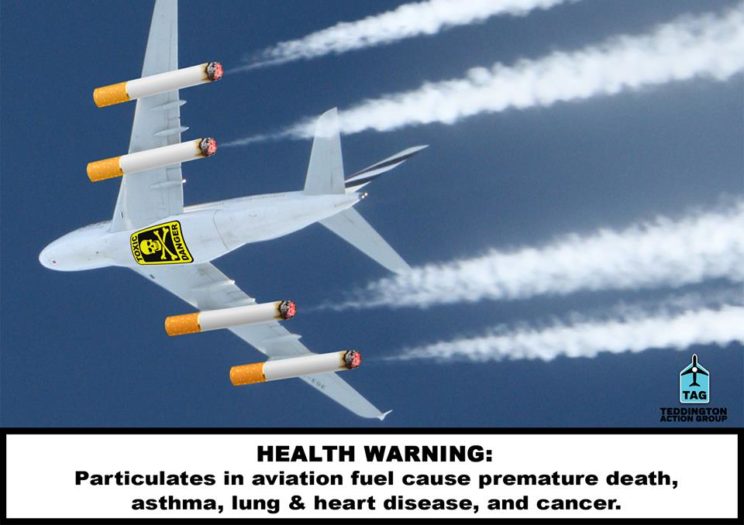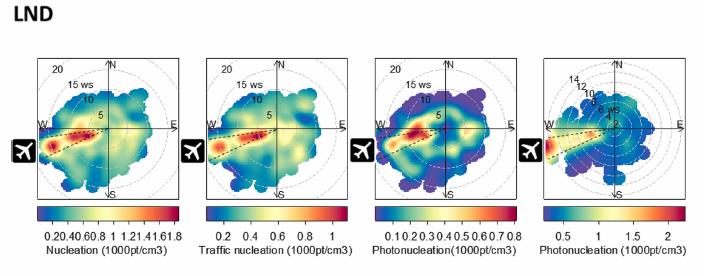EMISSIONS FROM AIRCRAFT ARE HARMFUL TO US ON THE GROUND (continued).

KCL has expressed the view that particulates from Heathrow operations travel into central London
TAG has already published an article on emissions from aircraft being harmful to us on the ground. We explained in that article that both the Department for Transport and Heathrow Airport maintain that planes in the air do not cause harm to us.
Kings College London has just published a research paper on this subject entitled “Source apportionment of particle number size distribution in urban background and traffic stations in four European cities” available to download from the Science Direct website at https://www.sciencedirect.com/science/article/pii/S016041201931832X?via%3Dihub with a synopsis version available from the news aggregator Phys.Org at https://phys.org/news/2020-01-pollution-heathrow-central-london.html. Both the Independent and the Evening Standard have reported on the publication of the research.
In this study, researchers identified, characterized and quantified the sources of ultrafine particulates in four European cities (Barcelona, Helsinki, London, and Zurich) between 2007 and 2017. They measured particle and gaseous pollutants at different sites and used a statistical model to identify and quantify the contribution of the different sources of ultrafine particles. The researchers divided the creation of the particulates (“nucleation”) into different sources and found that the greatest concentrations of the smallest particles occurred when the wind was blowing from the airport in all cities. This indicates that airports are a major ultrafine particle source and that these small particles can travel many kilometres. In the case of London, greatly elevated ultrafine particle measurements were identified when the wind was blowing from Heathrow airport. Figure 6 of the full research report shows this for all airports. The Heathrow section is reproduced below:

As can be seen from the prior TAG article, particulates have the ability to cause very substantial harm and with the increase in air traffic, it is particularly unfortunate that both Heathrow and the Department for Transport continue to maintain that aircraft flying over London cause no harm to air quality, when that is increasingly seen to be manifestly untrue. Research papers have existed since 2014 showing the emissions from aircraft being carried downwind for extensive distances. The Royal College of Physicians state that in each year in the UK, around 40,000 deaths are attributable to exposure to outdoor air pollution. The Government’s Committee on the Medical Effects of Air Pollutants state outdoor PM2.5s alone caused 28,861 deaths in 2010. Public Health England is reported to have recorded that the fraction of mortality in London due to particulates rose from 6.4% to 6.5% from 2016 to 2017 and from 5.6% to 6.4% from 2015 to 2016.
The aviation industry and the government department (which is staffed extensively with former members of the aviation industry) need to face up to reality and take responsibility for their actions. Failure is already causing substantial harm to people through bad air quality.

Thank you for drawing attention to this problem. Particulate pollution from aircraft is obviously an increasing problem, especially for Londoners. However, it occurs to me that particulates are also affecting people and wildlife everywhere in the countryside. May I draw your attention to the New Naturalist book, Insect Natural History by A. D. Imms (Collins, 1947), page 15:: ‘Iinsects have no lungs and breathe by means of an elaborate system of air tubes or tracheae, which branch in an intricate manner among the organs of the body. The ultimate branches of the air-tubes (spiracles) are less than 1 µ across, and it is in these minute vessels that the interchange of gases takes place.’
It seems very possible that aircraft pollution may in part be responsible for the decline in insects, particularly butterflies.My observations suggest that here in relatively rural North East Hampshire the decline in butterflies, variety and numbers, began about 1996.I have not read anywhere that this matter has been researched, but I suggest it may be an area worth investigation.